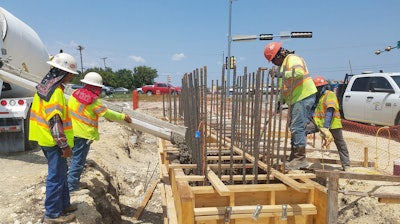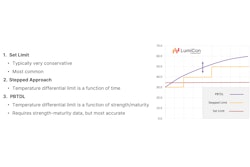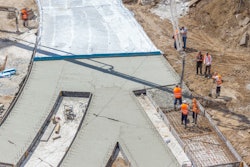
Placing concrete in hot weather necessitates extra precautions to ensure that the concrete sets properly and gains strength at a stable rate. Hot weather accelerates early-age strength gain, which can be an advantage in construction, but temperatures that are too high could cause concrete durability problems such as delayed ettringite formation (DEF) and excessive or drying shrinkage.
Therefore, regulating the temperature of concrete during curing in hot weather is essential minimizing durability issues and ensuring adequate strength is achieved. The American Concrete Institute (ACI) specifies in ACI 305R-10 "Guide to Hot Weather Concreting" recommended maximum concrete temperatures both at delivery and during curing. These recommendations are often mirrored as requirements in job specifications.
Monitoring the Internal Temperature of Concrete
To ensure the internal temperature of concrete remains below the maximum temperature threshold per ACI and/or project specifications, sensors can be embedded in the concrete to continuously monitor and record concrete temperature at regular intervals. This data informs the user of the concrete’s current temperature as well as temperature history, so the user can verify compliance with project specifications or take corrective action if the temperatures are approaching the limit identified in the specifications.
 Transtec Group
Transtec Group
Why Use Temperature Monitoring Hot Weather Concreting?
Temperature monitoring can aid the user in keeping fresh and early-age concrete below project-specified maximum temperatures during curing. Regulating the internal temperature of fresh concrete is crucial in hot weather because if it exceeds 158-160°F, the hydration process of the cement is altered, increasing the potential risk of DEF. DEF often does not appear for years after the concrete is poured, but once it does, it causes severe cracking that cannot be stopped.
Drying shrinkage is another durability issue exacerbated by high temperatures. Over time, moisture in concrete’s pores is lost through the cement hydration process and evaporation into the ambient. This loss of water causes the concrete to shrink, creating a potential for cracking. High temperatures can intensify the rate of water loss, increasing the potential for and severity of cracks.
Cracking caused by DEF and shrinkage can be severe, potentially compromising the integrity of the structure or leading to other durability issues from the cracks created. Ensuring that freshly-poured concrete follows thermal specifications is the best way to prevent durability issues like these, maximizing the concrete’s lifespan. Repair and reconstruction following deterioration can be expensive, so maintaining the integrity of the concrete from the beginning can save the owner and contractor thousands of dollars in the future.
 Transtec Group
Transtec Group
Using COMMAND Center in Hot Weather Concreting
Continuous temperature monitoring, particularly at delivery and during early age, is essential to pouring concrete in hot weather to ensure that the concrete does not exceed maximum temperature specifications. Though thermometers can be used to measure concrete upon delivery to the site, an embedded monitoring system is needed to continuously monitor early-age temperature gain in-situ. Using a non-destructive monitoring system such as COMMAND Center is the best choice for users to know throughout the curing process if their concrete is meeting a project’s thermal specifications.
The COMMAND Center system is the optimal choice for monitoring because it is affordable, easy to use, and has been proven to be reliable in the field. The system includes sensors and powerful software for viewing, analyzing, and reporting data. Sensors come pre-programmed and do not require initialization in the field. COMMAND Center software is free and allows the user to toggle between Celsius and Fahrenheit as well as view and analyze temperature data for individual sensors or compare data from multiple sensors at once—ideal for monitoring the temperature differential between the concrete and ambient or comparing the temperature at multiple internal locations.
Temperature monitoring of hot weather concrete is required in most hot-weather concreting applications and is essential to preventing delayed ettringite formation and drying shrinkage, maximizing long-term durability and minimizing repair costs. The COMMAND Center system provides a user-friendly, affordable option for this purpose. By continuously collecting temperature data, users can optimize hot-weather curing and prevent deterioration years before it begins.
Written by Sabrina I. Garber, MSE, COMMAND Center Project Manager at The Transtec Group. Reach Sabrina at [email protected].


















